Winner: Tie
It's a tough call to pick a winner here. It's down to your own tastes at the end of the day. The Model 3, in our opinion, is more conventional in its design. The IONIQ 5 is busier, more modern and more polarising.
Tesla has a cult-like fanbase. Hyundai does not. How does the newcomer IONIQ 5 compare with the EV old guard?

The Tesla Model 3 design hasn't changed much since it launched in 2017. It cuts a curvy form, with a front valance that has an almost Aston Martin-like elongated hump leading edge. Long, trailing headlights are also reminiscent of a British sports car from the early 2000s.
There's no large air intake as a car would conventionally have, which was quite groundbreaking when new. However, overall, we think the Model 3 now looks quite nondescript and safe. In 2021, Tesla face-lifted the Model 3, giving it sharper-looking wheels, altered headlights and a few other tweaks.
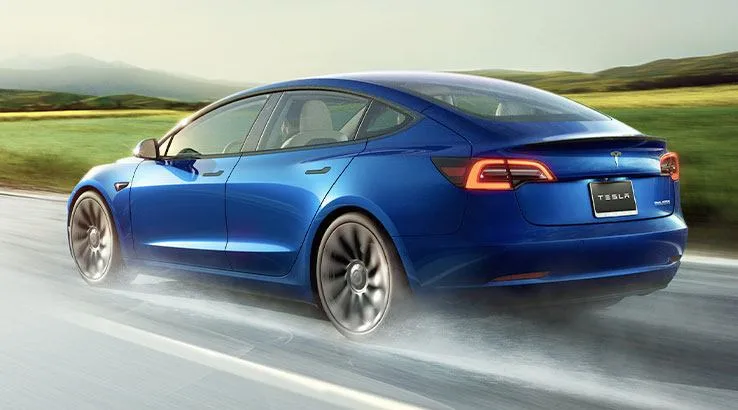
Contrasting the Model 3's rounded and curvy front end is a more crisp and conventional rear end. It looks like a sedan from the not-so-distant future.
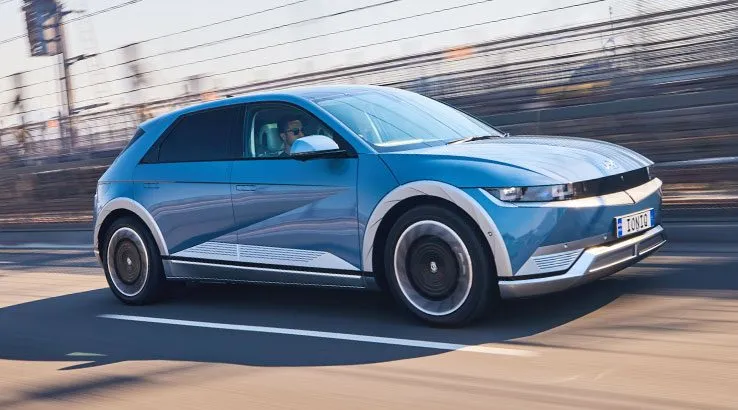
By contrast, the Hyundai iONIQ 5 has an interesting retro-futuristic style.
The front clamshell bonnet has a leading edge so sharp you could metaphorically shave with it. It has the feel of a concept car to it, especially when you see one in the flesh. Large parametric angular lines crisscross the side of the body and the wheel arch has contrasting fender flares, which Hyundai describes as "liquid metallic". It almost appears as if the car has driven through hot metal, which has then flung off the tyres, so perhaps that's where the name comes from.
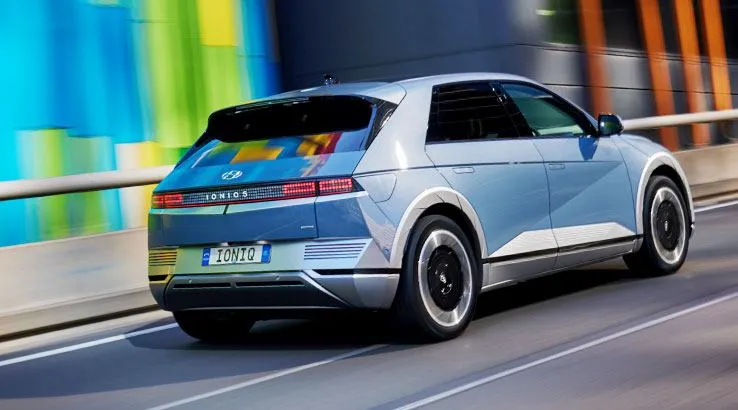
There's a lot more detail at the rear of the IONIQ 5, compared to the Model 3, it's pretty busy. The taillight cluster is made up of pixelated dots. The bumper ties in with the wheel arches in a contrasting colour. There's a subtle wing/spoiler above the rear window.
It's a tough call to pick a winner here. It's down to your own tastes at the end of the day. The Model 3, in our opinion, is more conventional in its design. The IONIQ 5 is busier, more modern and more polarising.
Driveaway, the Tesla Model 3 starts from $69,061 for a claimed 491km of range. That works out to $140.67 per kilometre of range. The Long Range Model 3 starts from $81,976 driveaway and has a claimed range of 602km, or $136.17 per kilometre of range. The Performance Model 3, with a range of 547km, starts from $98,765 driveaway, which works out to $180.55 per kilometre.
The Hyundai IONIQ 5 starts from $77,193.46, for a claimed 451km of range. That equates to $171.16 per kilometre of range. The AWD IONIQ 5 starts from $81,393.46 driveaway and is given a claimed range of 430km, or $189.28 per kilometre of range.
Hyundai lists the IONIQ 5 has currently sold out, with more coming in the near future. You can register your interest with Hyundai on its website. The Model 3 has a 6–9 month waiting list.
You can get into a Tesla Model 3 for less outlay than the IONIQ 5. All Model 3s beat their IONIQ 5 equivalent on range too, by significant margins.
How do the passenger cabins of these electric vehicles compare?
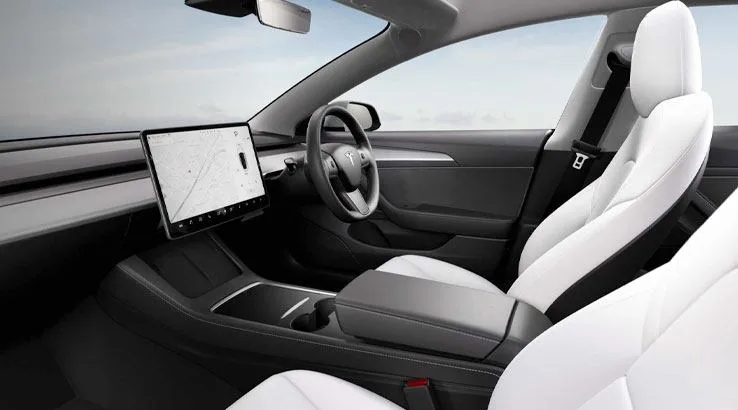
The interior of the Model 3 is probably one of the most minimal of all cars currently on sale. The most prominent feature has to be the giant 15-inch touch display. Unconventionally, this is the only screen in the car and it serves as the main place to go for adjusting car settings. You can get your Model 3 in an interesting $1,500 optional colour combination that features white vegan leather seats.
The Model 3 is full of Easter eggs, demonstrating the company's playful side. You'll find things like Caraoke, Netflix, YouTube and even a built-in fart prank function called "Emissions Testing Mode".
It's not all gimmicks though.
Car reviewers said that the Tesla Model 3 was comfortable to the extreme, with one going so far as saying the driving position was effectively perfect.
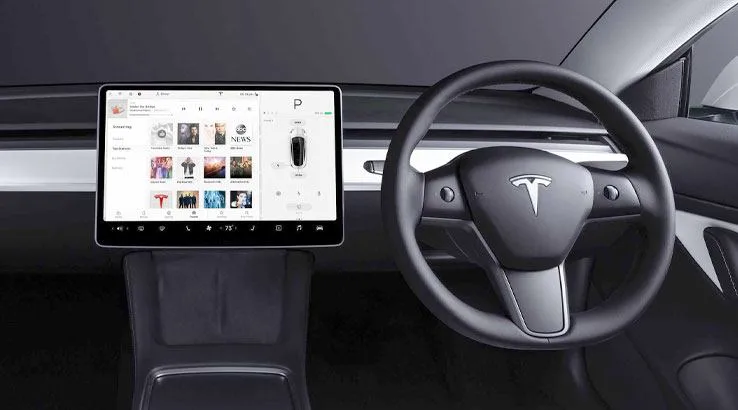
Standard features:
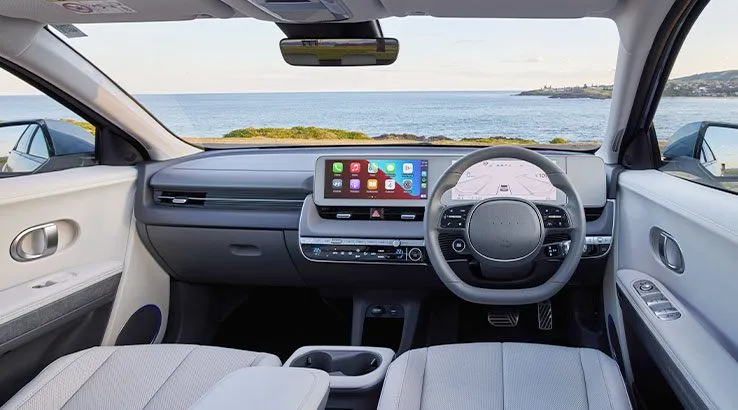
The Hyundai IONIQ isn't quite as minimal as the Model 3.
The IONIQ 5, in our eyes, is quite space age in its design. There are several different interior colour combos, from Obsidian Black leather to the unusual Dove Grey/Dark Teal. That's about 4 more combinations than the Model 3 has.
The most noticeable thing is the dash screens, which both measure 12.3 inches. The dashboard is super slimline, thanks to the clever relocation of some HVAC parts. Unlike any car we've ever seen, the glove box slides open, just like a drawer. It's a simple, yet innovative idea.
Just like the Model 3, the floor of the IONIQ 5 is completely flat, as it's built on a dedicated EV skateboard platform. The E-GMP architecture is (if rumours are to be believed) potentially underpinning an Apple car. Uniquely, you can slide the centre armrest fore and aft by 140mm. It has a bit of a pretentious name, "Universal Island". It's also possible for second-row occupants to shift their seats back by 135mm for even more legroom.
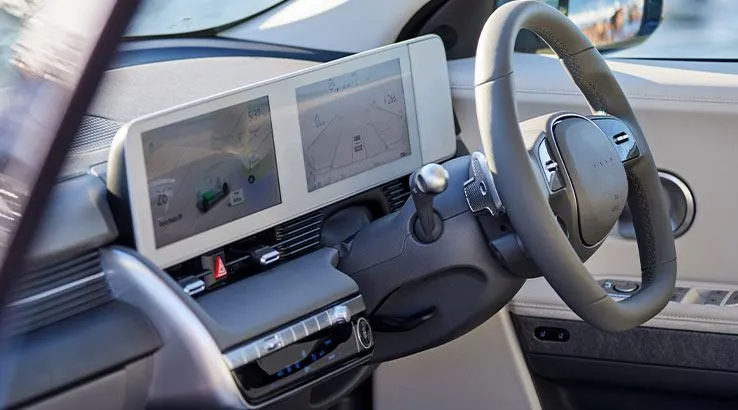
Standard equipment:
Reviewers said the IONIQ 5 was limousine-esque in its interior dimensions. They also said it was pretty conventional in appearance, once you've sat in the Model 3. Apparently, the Hyundai feels lighter, plus you can recline the seats while you wait for your IONIQ 5 to charge. Compare that with the second row of the Model 3 and reviewers said it's a second-class experience for rearward passengers.
Reportedly, the IONIQ 5 outdoes the Model 3 on build quality. Countering that, reviewers felt the Tesla app was better than Hyundai's.
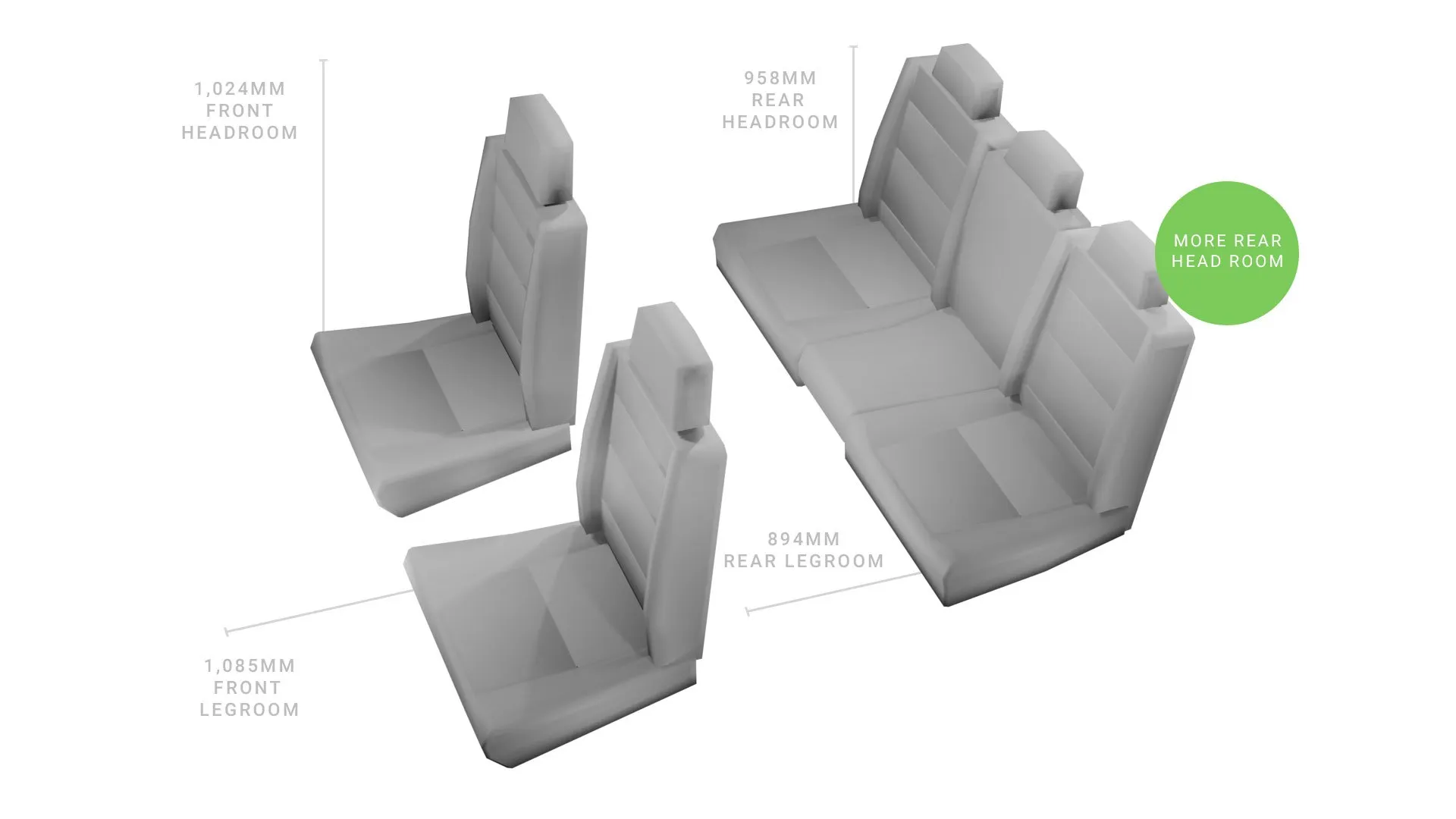
The Model 3's figures are secreted away, deep in the owner's manual.
Front passengers can stretch out their legs in 1,085mm of space. They have 1,024mm of headroom and 1,430mm of shoulder room. Front hip room measures 1,356mm.
Second-row travellers get 894mm of legroom and headroom measuring 958mm. Shoulder room available is 1,372mm and hip room in the back is 1,331mm.
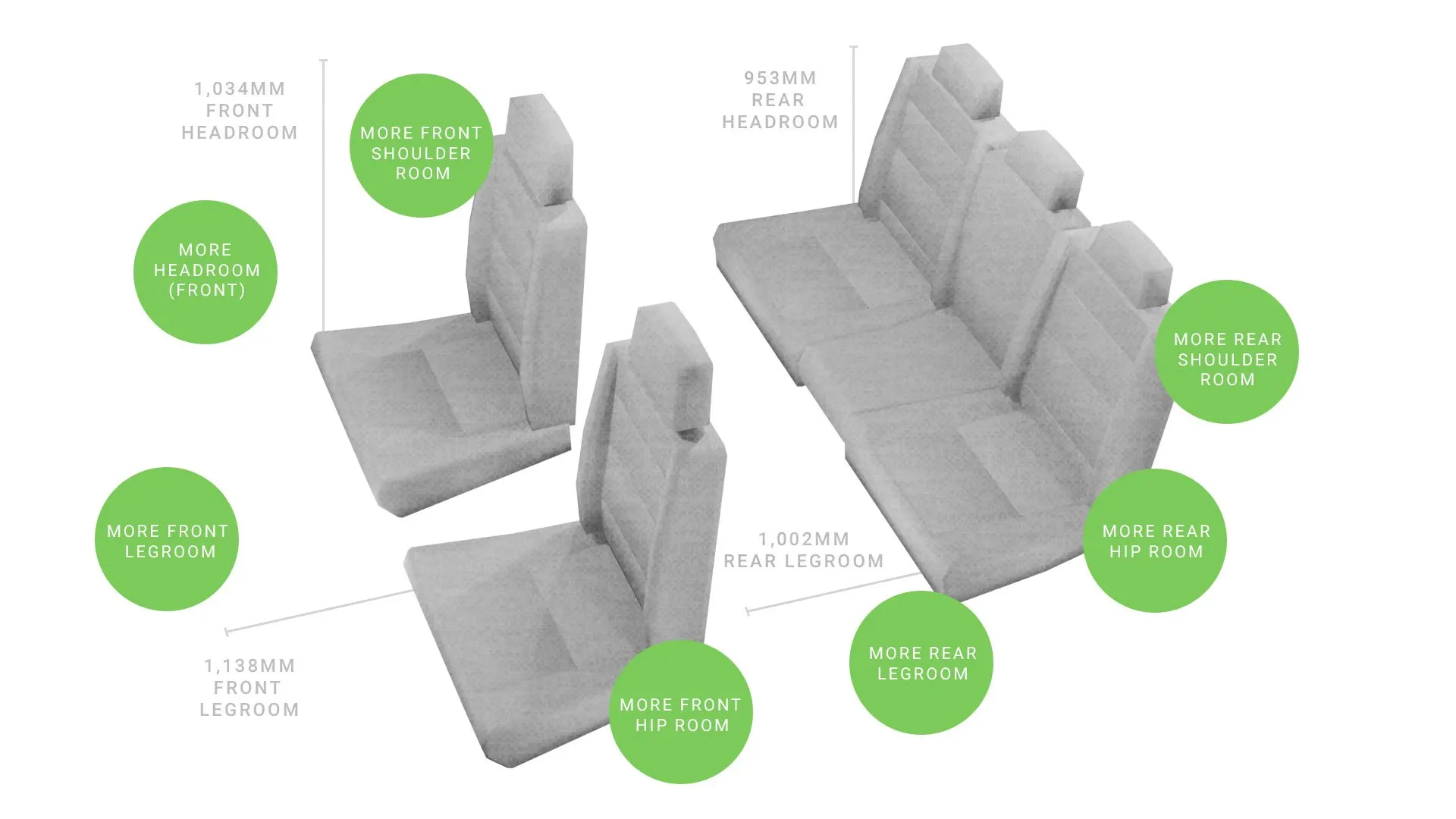
The Hyundai IONIQ 5 is a much bigger vehicle. It has 1,138mm of front legroom and 1,034mm of headroom. Rugby players and bodybuilders will be happy as there's 1,465mm of front shoulder room. Hip room for front passengers is measured at 1,368mm.
Rearwards, passengers have 1,002mm of legroom, 953mm of rear headroom, 1,465mm of shoulder room and 1,362mm of hip room.
| Hyundai IONIQ 5 | Tesla Model 3 |
|---|---|
|
|
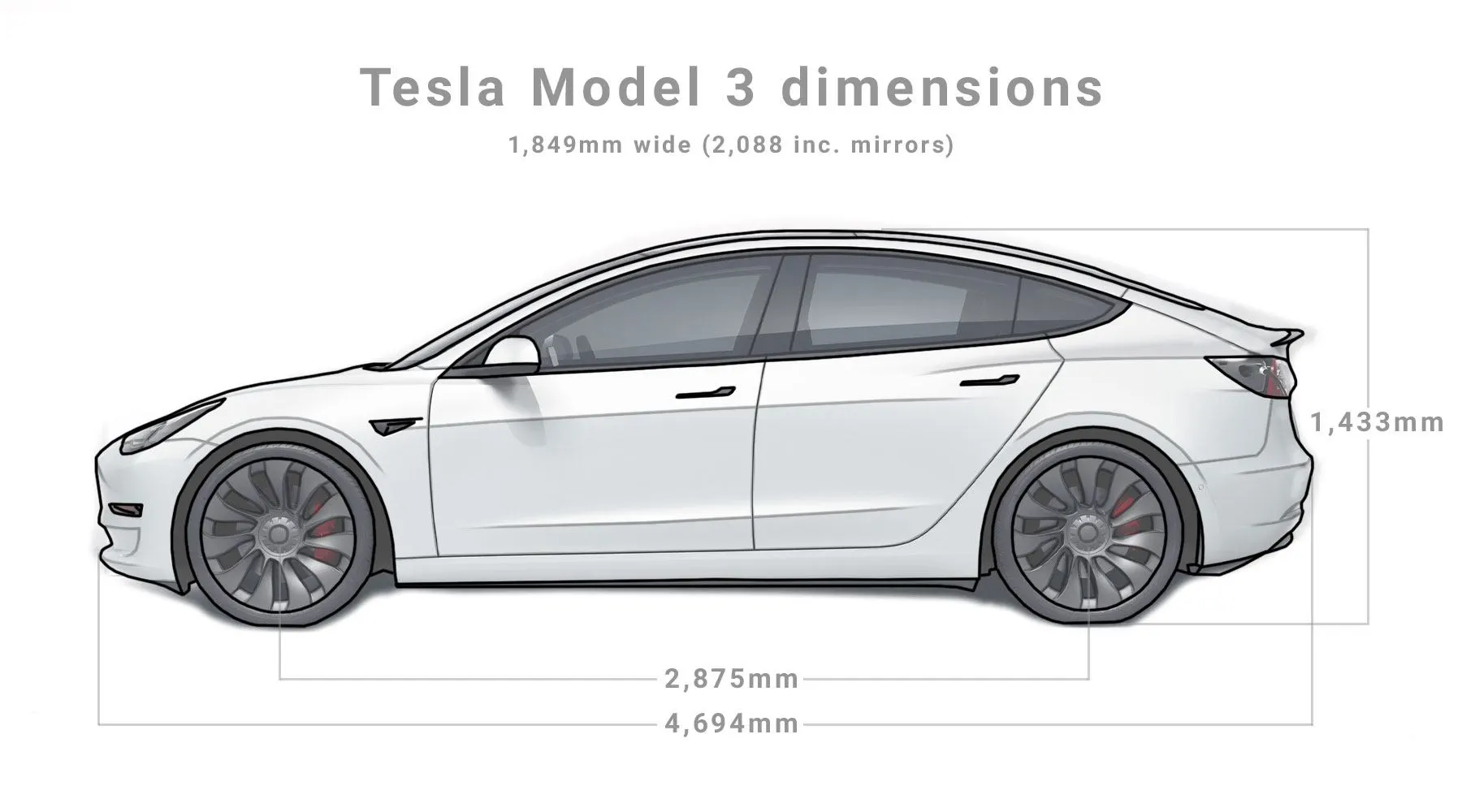
The Model 3's body is 59mm longer than the IONIQ 5, though the wheelbase is 125mm shorter. The Model 3 is narrower, excluding the mirrors, by 41mm. The Model 3 is 214mm lower than the IONIQ 5.
A single motor Model 3 weighs 1,625kg, while dual-motor models tip the scales at 1,844kg.
The Model 3 has a total of 649 litres of cargo storage. The front trunk has a volume of 88 litres. The Model 3's turning circle is given as 11.6 metres in the owner's manual.
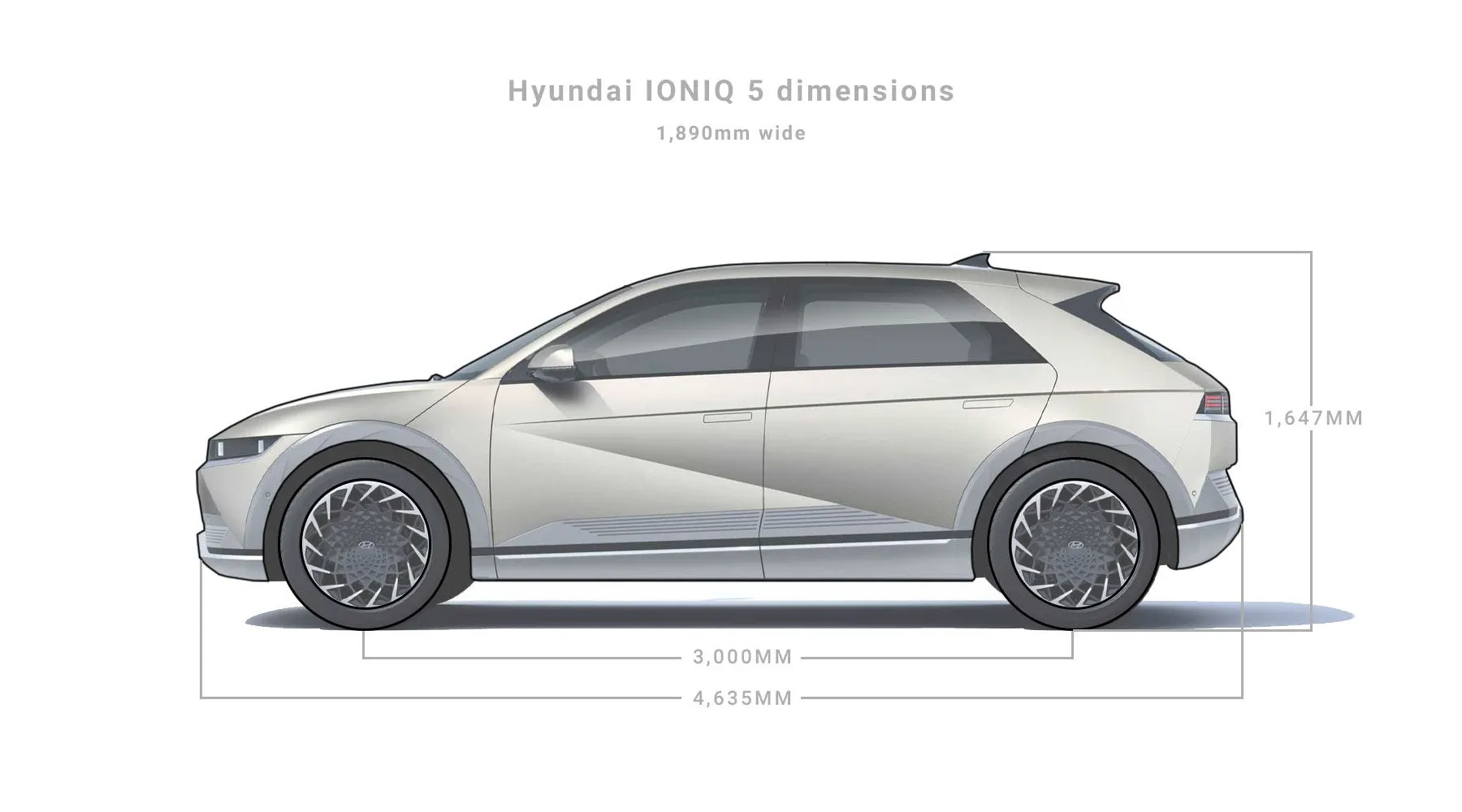
Meanwhile, the Hyundai IONIQ 5's body is 4,635mm long. Its wheelbase is 3 metres on the nose. It's 1,890mm wide and 1,646mm tall (including that shark fin antenna).
Empty, the IONIQ 5 2WD weighs in at 2,020kg, while an AWD is 2,100kg.
Storage-wise, the IONIQ 5 2WD has 593 litres of cargo volume (including the glovebox), while the AWD model has 560 litres.
The IONIQ 5 has a turning circle of 11.98m.
The Hyundai IONIQ 5 is a heavier, higher, shorter in length and wider vehicle. It's also got a 38cm larger turning circle. The Model 3 is lighter, longer, less tall and has a shorter wheelbase.
We've given the win to the Model 3 here, as it technically has more storage and should be slightly more manoeuvrable.
The average insurance premium (fully comp, 40-year-old rating 1 driver, garaged in NSW) for the Tesla Model 3 range was $1,452.35. The Hyundai IONIQ 5 averaged out to $1,025.01.
The average costs per model, were:
| Annual insurance premium (average) | |
|---|---|
| Tesla Model 3 | $1,140.95 |
| Tesla Model 3 Long Range | $1,378.33 |
| Tesla Model 3 Performance | $1,837.79 |
| Hyundai IONIQ 5 2WD | $1,013.06 |
| Hyundai IONIQ AWD | $1,036.97 |
With less potent acceleration and the backing of a mass manufacturer, the Hyundai IONIQ 5 worked out $427.34 cheaper annually. It's also the cheapest outright, with a 2WD model costing on average $1,013.06.
| Winner | ||
|---|---|---|
| Tesla Model 3 | Hyundai IONIQ 5 | |
| Price. The range-opening Tesla Model 3 is cheaper than the IONIQ 5's entry-point, by $8,132.46. However, the Model 3 does have a higher average price, $83,267.33, versus the IONIQ 5's $79,293.46. | ✅ | ❌ |
| Range. Again the Model 3 wins here, with every single model having a higher range than the IONIQ 5. The 2WD model IONIQ 5 has the best range, with a theoretical 451km possible, while the Model 3 with the least range will travel an extra 40km on top of that. | ✅ | ❌ |
| Charging infrastructure. A clear win for the Tesla, thanks to its exclusive Supercharger network and the destination charging points. The IONIQ 5 can only charge at third-party charging networks, while the Model 3 can use both. There are 65 Superchargers dotted around Australia, with the strongest concentrations found around urban hubs. | ✅ | ❌ |
| Charging times. Hook a Model up to a 50kW charger and you can go from 10–80% in 56 minutes, according to estimates from one source. Plugging into a 150kW charge point brings those times down to 28 minutes. On an 11kW home charger, restoring charge is estimated to take 6 hours and 15 minutes approximately. It needs to be known that we couldn't find official Tesla charge time figures. In the IONIQ 5 manual, charge times are published as 56 minutes and 30 seconds (to 80%) when using a 50kW charger for a 2WD (buy an AWD and that figure jumps to 61 minutes and 42 seconds). Connected to a 10.5kW wall charger, the duration is listed as 6 hours and 6 minutes. Doing some maths, we calculate that the IONIQ 5 could recharge from 10–90% in about 25 minutes if using a 150kW rapid charger. The Tesla is quicker to recharge on a 50kW charge (by 30 seconds), but slower to charge using an 11kW wall charger or 150kW point. We'll give this one to the IONIQ 5, even though the Model 3 has more range and theoretically you'll need to charge it less versus the IONIQ 5. | ❌ | ✅ |
| Looks. Yes, styling is hugely individual. We prefer the styling of the Model 3 to the Hyundai IONIQ 5, it is more conventional and less attention-grabbing. | ✅ | ❌ |
| Interior styling. The Tesla's minimal interior is very pleasing to the eye, while the IONIQ 5's is a little more conventional and fussy, due to the extra switchgear. | ✅ | ❌ |
| Interior space. The Hyundai is a much larger vehicle internally than the Model 3. The only area the Model 3 beats the Korean EV is rear headroom. | ❌ | ✅ |
| Interior storage. According to the owner's manual, Tesla's Model 3 has a total of 649 litres storage (with 5 passengers). According to the spec sheet, the Hyundai IONIQ 5 has a total of 593 litres (as a 2WD) and 560 litres as an AWD. The win has to go to the Model 3 here. | ✅ | ❌ |
| Instrument cluster. Tesla puts everything into the central display, which while neat-looking, gets a lot of negative comments. It requires you to look away from the road to see what speed you're doing. The reason? Elon Musk says that with automated cars, it's less important to know things like that. He asked one Twitter user "How often do you look at the speed in a taxi?" It kind of feels like innovating for the sake of it. The IONIQ 5 has an instrument cluster that's where pretty much every other car ever made has one. Behind the steering wheel. | ❌ | ✅ |
| Infotainment system. Tesla uses Linux to underpin its infotainment system. It's full of fun little features, like a whoopee cushion and lots of references to film cars. One Tesla owner said each software update is like waking up on Christmas morning with heaps of new features. The IONIQ 5, by comparison, is humdrum. One of the testers liked its cohesive phone-like home screen. However, they found that because the icons have a unified colour scheme, it was harder to pick the right app quickly. They did go on to add that they prefer to use smartphone mirroring whenever possible normally. As do we. However, Tesla doesn't support this. Therefore, even though the Model 3's infotainment system is bursting with playful apps and tricks, we'd pick the Hyundai's infotainment system every day of the week. A neat feature is you can also customise the steering wheel button controls. Having more physical, dedicated switchgear is also a big bonus as some testers bemoaned the Model 3's heavy reliance on touchscreen controls. | ❌ | ✅ |
| Towing. The Tesla Model 3 owner's manual says you should not tow with the Model 3. On the other hand, an IONIQ 5 can tow up to 1,600kg braked. On the IONIQ 5, the tow bar kit has an RRP of $1,490, including fitting. | ❌ | ✅ |
Driver assists. The Hyundai IONIQ 5 has SmartSense, a system of safety assists that many new Hyundais possess. This is on top of other, more traditional safety functions. SmartSense includes things like:
The car has more assists on top of that. ANCAP rated the IONIQ 5 as 88% for adult occupation protection, 87% for child protection, 63% for vulnerable road user protection and 89% for safety assists. The Model 3 scored 96%, 87%, 74% and 94% respectively. The Model 3 also has a blind-spot monitor, forward collision warning (FCW), lane keep assist and adaptive cruise control. Across the board, the Model 3 scored on par with, or better than, the IONIQ 5 with ANCAP (though it was tested in 2019), so we'll give the win to the Model 3. | ✅ | ❌ |
| Packs. With the Tesla Model 3, there's only 1 pack on sale. Tesla calls it "Full Self-Driving Capability" and it costs $10,100. There are no packs for the Hyundai IONIQ 5 to the same level as Tesla's self-driving add-on. There is one that could be considered a package, the Body Styling Trim kit, that costs $679 and adds Gloss Black exterior body components. Hyundai clearly lists optional extra prices. Tesla only has 1 pack. We're giving the win to Hyundai here. | ❌ | ✅ |
| AWD. The Hyundai iONIQ 5 and the Tesla Model 3 are available as a RWD and an AWD, depending on the trim you opt for. We'll call this a tie. | ✅ | ✅ |
| Marketing materials. Hyundai beats Tesla here, by a huge margin. You can download a comprehensive spec table for the IONIQ 5 that allows you to compare different trim grades at a glance. This is how the majority of carmakers have done things for years. Tesla doesn't produce such a document and doesn't make an exhaustive list of features available. Instead, you have to glean the info from multiple sources, which sometimes aren't official. Hyundai earns an easy point here. | ❌ | ✅ |
| Smartphone connectivity. In a strange omission, the Model 3 doesn't have Apple CarPlay or Android Auto. In fact, if you check on Twitter, it's one of the most requested things that people talk about. Apple CarPlay is available in more than 600 models now. Just not in any Tesla. The IONIQ 5 has both Apple CarPlay and Android Auto. | ❌ | ✅ |
| Availability. The Model 3 has waiting times of around 6–9 months according to the Tesla Australia website. Privately, there are 18 for sale nationally on Autotrader. Australia's second allocation of 109 IONIQ 5s sold out in under 7 minutes, with reports suggesting there were up to 16,000 registrations of interest. There's a single IONIQ 5 listed on Autotrader for sale and it is priced quite a lot higher than the driveway cost for an IONIQ 5. Hyundai Australia simply says it is placing an order for more EVs shortly. The Model 3 wins thanks to its slightly wider availability. | ✅ | ❌ |
| Transmission tunnel. Neither the Model 3 nor the IONIQ 5 have a transmission tunnel down the body, thanks to the skateboard chassis design they use. That means the floor is completely flat, making the second row easier to enter and exit. | ✅ | ✅ |
| Quality. According to some testers, the Model 3's build quality isn't its main selling point. If you Google Model 3 and build quality, there does seem to be a large number of articles and comments about issues the Model 3 has had. Owners commented that they thought their Model 3 was assembled to a satisfactory, or fine, level. There are some indications that the quality assurance can fluctuate, but most of the commonly cited problems we found were fixed with a trip to a Tesla Service Centre. One tester said that the Hyundai IONIQ 5 was probably the best made Hyundai and it sat just below the brand's luxury wing, Genesis. It scored very highly with reviewers for its fit and finish, so we'll give the win to the more established brand. | ❌ | ✅ |
| Warranty. Tesla's basic vehicle warranty lasts 4 years or 80,000km. Covering the battery and drive unit is an 8-year, 192,000km warranty. Hyundai outdoes Tesla's standard vehicle warranty, applying a 5-year, unlimited kilometre guarantee. The battery warranty is the same length, 8 years, but has a lower kilometre cap (160,000km). Still, we've got to give the point to Hyundai here for offering Australia's first EV 5-year warranty. | ❌ | ✅ |
| Handling. Testers decided that the Model 3 edges out the IONIQ 5 in the handling department. In the IONIQ 5, you're sat up a smidge higher than a normal hatchback, while the Model 3 is hunkered down. One of the reviewers determined that the Model 3 had a more consistent and direct steering response while delivering a generally more agile feel. That same motoring expert said the IONIQ 5 wasn't bad to drive, it just wasn't as much fun as the Model 3. It seems the IONIQ 5 is perhaps a little softer around the edges and more supple in its suspension set-up, favouring comfort over liveliness. It depends on what you're looking for in a car, but for most driving purists, the Model 3 sounds like it's the one to go for. | ✅ | ❌ |
| Dimensions. The Model 3 is a longer, lower and narrower vehicle. While the IONIQ 5 is taller, wider and shorter, it does offer far superior interior room. We'll give the tick to the IONIQ 5. | ❌ | ✅ |
| Acceleration. Few cars can touch the Model 3's startling 0–100km/h time, especially under the $100,000 mark. Officially, it has a 3.3-second 0–100km/h, if you discount the rollout. That's to allow the timing beam to go from the leading edge of the car's front tyre to the rear edge, which means the car is already moving when the timer officially starts. The Model 3 RWD covers the ground to 100km/h in 6.1 seconds, while the Long Range manages it in 4.4 seconds. The IONIQ 5 AWD can get somewhere near Tesla times with a 5.2-second 0–100, but the 2WD languishes in pretty average territory, with a claimed 7.4-second time. We have to give the tick to Tesla for having the guts to sell a car that is almost as quick as a supercar. | ✅ | ❌ |
| Climate transparency. Tesla publishes a climate impact report, though the 2021 document isn't out yet. This covers things like lifecycle analysis of its vehicles, battery recycling efforts, water used and waste produced in vehicle manufacturing. The Hyundai Motor Company generates a yearly sustainability report, which evaluates the brand's carbon reduction and environmental management efforts. Let's call it a tie. | ✅ | ✅ |
| Total: | 13 | 14 |
Tesla, Inc., a relative newcomer (in car-making terms), was only founded back in 2003, though the first car didn't come until 2008. Famously, Elon Musk is a co-founder of the company. Last year, the Model 3 broke into the top 20 best-selling models worldwide.
Korean car-building giant, Hyundai. The brand is the largest South Korean carmaker and has the world's largest vehicle production facility. Hyundai also builds other electric vehicles, like the IONIQ and the KONA EV SUV.
It depends on your circumstances. The biggest buying consideration is likely your budget.
The Model 3 is the most wallet-friendly, with the entry-level model priced well within most states' EV subsidy thresholds.
Then you may want to buy based on range. Again, the Model 3 is the one to go for there. Looks are important to people. For some, the IONIQ 5's radical exterior will impress; for others, the Model 3's popular, simple and inoffensive styling is what grabs their interest.
Internally, the IONIQ 5 is much larger, plus the cabin has several unique features that the Model 3 can't match.
How do they stack up?
The Model 3 has:
The Hyundai IONIQ 5 has:
To determine which is the best EV for you, you need to test drive them both, so you can see how they fit in with your daily driving.
Pictures: Supplied
The future’s electric – and it wants to burn rubber
It's faster than a BMW 3 Series, more unique than a Mercedes C-Class and loaded with features that make it feel every bit as premium.
The VW Golf is back - and it's got more of everything.
Skoda refines its family-friendly performance car with more features, more power and a competitive price.
Peugeot have made a van that whispers while it works.
Toyota gave a Corolla muscles and a megaphone and it’s glorious.
Born for the trail, adapted for the tarmac
This is a car for people who want their SUV to go vroom in a way that no Nissan X-Trail or Toyota RAV4 could ever dream of.
Let us assist you in picking your next SUV.
Which electric car should you buy in 2021? Find out with our complete EV guide.